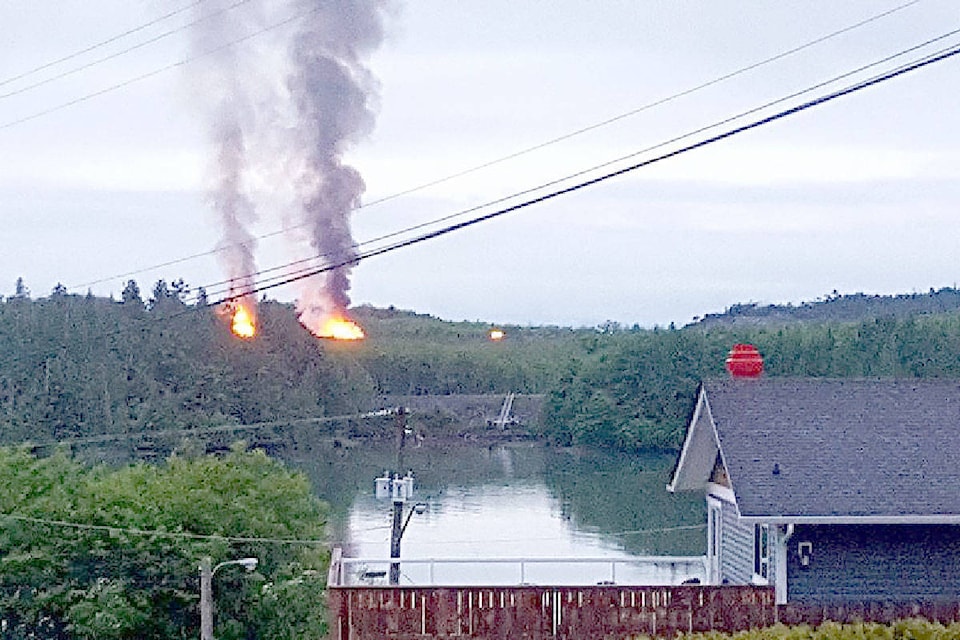James Storey admitted he had not reviewed the provincial Open Burning Smoke Control Regulation before carrying out a waste material burn on Ridley Island during Day 4 testimony at the Ridley Island burn trial in Prince Rupert provincial court.
Storey’s Excavating was contracted by the Prince Rupert Port Authority to carry out the burn that took place from June 22-27, 2017.
The PRPA now faces four charges, laid by the B.C. Ministry of Environment, for introducing waste into the environment, open burning of prohibited material and continued open burning for a period longer than permitted.
During testimony, Storey said he had only reviewed the Prince Rupert Port Authority’s (PRPA) open burning protocol provided to him by the CT Northern Contractors Alliance.
When asked if he had reviewed a copy of the provincial Open Burning Smoke Control Regulation– enforced from Feb. 29, 2016 until June 14, 2018 – the company owner of Storey’s Excavating replied “no”.
Waste materials allegedly burned over the five days included treated wood waste from pilings that were part of the old Odin Dock that was once located in Cow Bay.
READ MORE: Video of burnt treated materials shown on day one of Prince Rupert Port Authority trial
Storey confirmed, when asked, that PRPA’s policy states that contractors must adhere to the provincial Open Burning Smoke Control Regulation.
Storey also confirmed that the protocol requires a venting index of “good” on the day of emission and an expected “good” or “fair” for the following day. As well, he was required to keep daily records of the venting forecast of Prince Rupert and Ridley Island area, weather conditions and estimated volume of debris (the amount of debris being burned).
Storey said in the past he would call the Ministry of Environment Regional Office in Smithers for the ventilation index to speak with a meteorologist who would provide them with a custom ventilation index.
This time, he said, when his brother Ryan Storey called the office in Smithers they directed him to their website which said to do a test burn and adhere to the burning regulations.
The Crown lawyer then presented Storey with an affidavit from Environment Canada with the British Colombia ventilation records kept by the Ministry of Environment. When asked, he said that he had never seen those records or requested them. Storey said he had relied on his brother, who is the superintendent of the company, for the information provided and had not personally communicated with the ministry at that time.
READ MORE: Port charged with burying burnt remains of treated wood
Storey also said that it made sense to him that regulations changed to a test burn because previous ventilation indexes from Smithers had never accurately represented Prince Rupert’s forecast.
On June 11, Day 2 of the trial, Gareth Scrivner, formerly a conservation officer based in Terrace, testified that it is possible to get a custom index by calling meteorologists to interpret Environment Canada’s daily weather data. However, he also confirmed, when asked, that the website does not clearly state where a person or company may receive a custom ventilation index.
According to the smoke control forecast for B.C., issued by Environment Canada on Thursday, June 22, 2017, the burn forecast for Terrace, the closest publicly available data to Prince Rupert, was ranked as “poor” as of 7 a.m. and “good” as of 4 p.m on the first day of the fire.
One of the charges PRPA faces is for burning for a period longer than permitted — 60 hours for Port Edward and 72 hours for Prince Rupert and Ridley Island area — but Storey said this issue has never been raised for other burnings that his company had done for the port.
The court also heard from Ronald Hansen, a paving superintendent with Peters Brother Construction.
On Day 2 of the trial, Matthew Keen, the Port Authority’s defence attorney, asked Scrivner if he investigated the possibility that asphalt paving could have been the source of the smell which witnesses said was in Port Edward during the time of the fire. Scrivner replied he never followed up during his investigation that asphalt may have caused the smell.
At Wednesday’s trial date, it was confirmed by Hansen that paving was going on in Port Edward from May 21 – July 17, 2017. Hansen also said, when asked, that they laid out 3,032 litres of tact (an asphalt product that acts like a bonding agent) and that workers were using torches on June 27 to soften the mix which had stuck to their shoes. During cross-examination he told the Crown lawyer that the smell of asphalt, in his experience, only spreads 20-30 metres before it dissipates.
To date, the Crown and defence presented all their evidence before the court. Final arguments are expected to be heard in mid-July.
